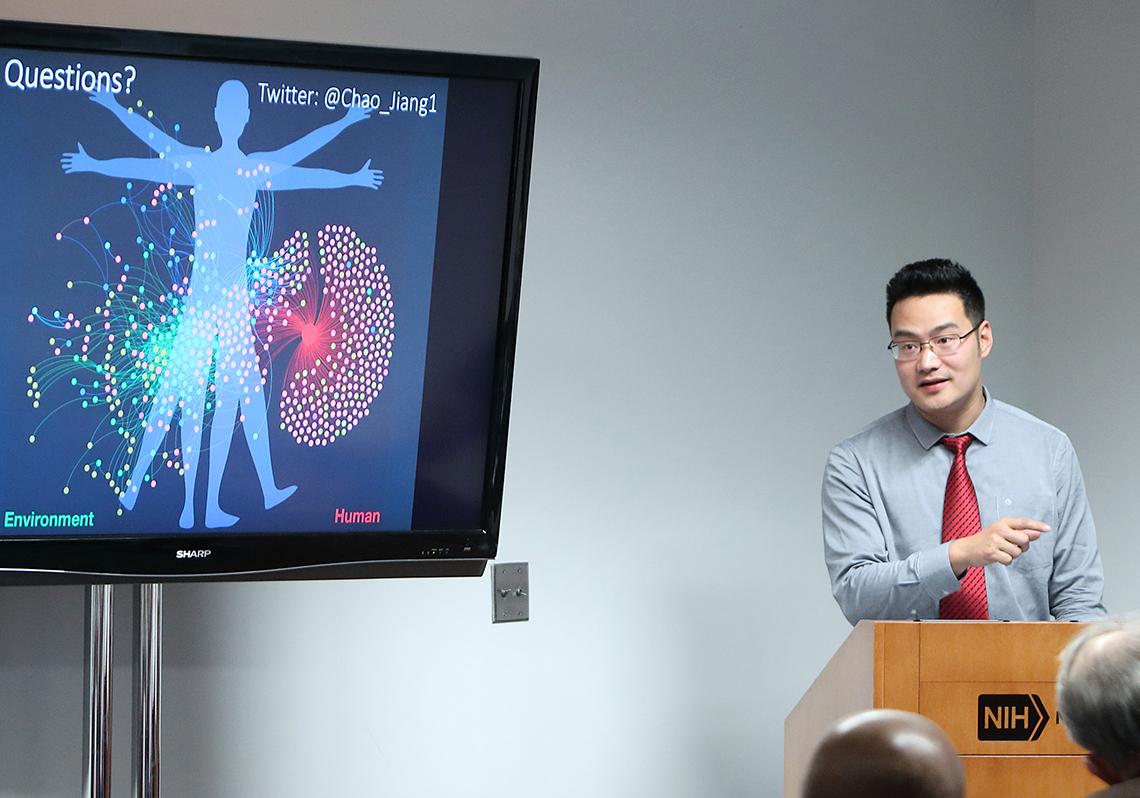Every Breath You Take
Exposome Tells Where You’ve Been, and When

Photo: Chia-Chi Charlie Chang
Every day, you encounter dozens of largely invisible microorganisms that are just hanging out in the atmosphere. You breathe them in. Your skin absorbs them. Most are harmless or exist in amounts so small they’re unlikely to hurt you. Some could make you sick. Imagine that there’s a way to identify and measure every substance you’re exposed to on a daily basis. That’s what visiting NIH Stadtman investigator Dr. Chao Jiang and his colleagues did a few years ago; they devised a method to capture and map an individual’s “exposome”—a person’s total environmental exposures.
“Human health can be basically viewed as an interplaying product of genetics, lifestyle and environmental exposures,” Jiang explained in “Exposing the Human Exposome,” an NHGRI Faculty Search Seminar held recently in Bldg. 49. “Decades of research we have so far has given us a lot of information on genetics, genomics…[and even insights on aspects of lifestyle, such as stress and diet]. However, comparatively speaking, we know very little about environmental exposures…the exposome is not well understood and poorly studied…so we wanted to know, could we track and quantify personal environmental exposures?”
Studies of what’s blowing in the wind have been conducted before, of course, especially in regions known to harbor harmful toxins—Ground Zero in NYC after 9/11 or Three Mile Island and Chernobyl after nuclear power plant disasters. However, the monitors in those investigations were stationary, installed in designated locations and not meant to be mobile. Jiang’s method is different, more personalized. It can travel with you.
A Stanford University postdoc in Dr. Michael Snyder’s lab and an inventor who has published extensively on bacterial genomics, Jiang and his labmates spent several years inventing a portable, battery-powered device—“smaller than an iPhone 6,” he noted wryly—that individuals can wear like an armband, or set up on their desks.
The mechanism includes sensors, a collection container with filter and a pump that simulates human breathing. The sensors can detect both biologicals (biotics) and chemicals (abiotics). So airborne substances from plants and pets as well as such common emissions as tobacco smoke and automobile fumes are all fair game for collection.

Photo: Allison Zhang
Jiang’s device also continuously measures atmospheric temperature, humidity and particle concentration.
For its longitudinal study, the research team recruited more than a dozen folks to use the device as they went about their daily lives—for several weeks or months and up to 890 days, in the case of one wearer. All 15 volunteers were San Francisco Bay-area residents, males and females ages 28-61. Some traveled—across North America, Europe and parts of Asia; others stayed primarily in their own geographical comfort zone.
Results, which the team analyzed and categorized using DNA and RNA sequencing samples, were fascinating and informative. The study also contains broad implications for public health.

Photo: Alex Wild, University of Texas-Austin/Wikicommons
“So there were all sorts of different particles,” Jiang said, showing slides from analysis of the data sample. “We saw plant pollens from the different plant species and contact spores…There were also brochosomes, which I would never have known about without doing this project. They look like viral particles, in a sense, but it’s actually some sort of hydrophobic proteins/lipids mixture made by insects as a waterproof mechanism on their body.”
The researchers identified more than 2,500 species, including bacteria, fungi, plants, Metazoa and more than 200 viruses.
“We know that the exposome is highly diverse, but also highly dynamic,” Jiang said.
His team was able to determine not only where volunteers had been, but also approximately when they’d traveled.
“The seasons were pretty much a major driving factor, with all of the changes in temperature, humidity and other things,” he explained.

Photo: Roman Rakitov/Wikicommons
For example, he noted, pine pollen in northern California is heaviest in late spring or early summer. Jiang’s analysis of samples clearly showed times that wearers had spent in that region, when dense concentrations of pine pollen were detected. Other geographic regions revealed similar unique characteristics.
“This can really be a validation of our approach,” Jiang said. “We were actually following people around, but of course the people are exposed to everything floating around them, so even environmental species with seasonal patterns we were able to detect. [However], instead of just one or two species we were able to do hundreds at the same time…With so many seasonal signatures in our data we were able to construct a seasonal prediction model.”
The study enabled chemical profiling as well, Jiang pointed out. “Chemicals are influenced by locations,” he noted. “Chemicals are correlated with biologicals.”
All told, Jiang tracked 66 locations from across the U.S.—California, Montana, Texas, Michigan as well as Boston and Bethesda—to as far away as Indonesia and Australia. Participant 1 (P1) provided the most data, carrying around the device for nearly 2½ years. A 66-year-old university professor, P1 also traveled frequently, so the portability of the device and data collection methods were thoroughly tested.
The study, published in Cell in September 2018, also found that “people can have distinct personalized exposomes, even when geographically close.”
And, if knowing about all of the hitchhikers you inadvertently pick up everyday creeps you out a bit, Jiang’s group also concluded that the overwhelming majority of microscopic riders are safe. In addition, air pollution isn’t nearly as much of a health problem in the U.S. as it is in India and China.
As for next steps in the research, Jiang and colleagues plan to fine-tune the device filter so it can better detect and identify disease microbes.

Photo: Chia-Chi Charlie Chang
In an interesting future personal exposome study, Jiang is launching an investigation of mysterious colic. Using criteria dating back to the 1950s, doctors diagnose babies with colic when they cry for 3 hours a day for at least 3 days a week over the course of 3 weeks. Once physical and medical causes are ruled out, pediatricians deem the upset “mysterious.”
“The idea is to try to establish a longitudinal comprehensive exposure profile and long-term tracking,” Jiang concluded, “so maybe we can see what is changing before the onset of colic as well as what happens before its regression. Then we may be able to provide some therapeutic targets.”
